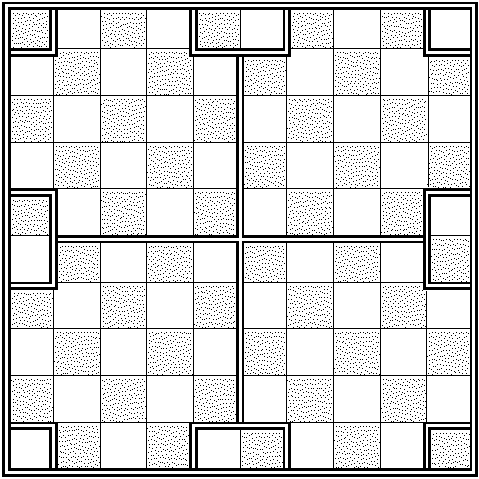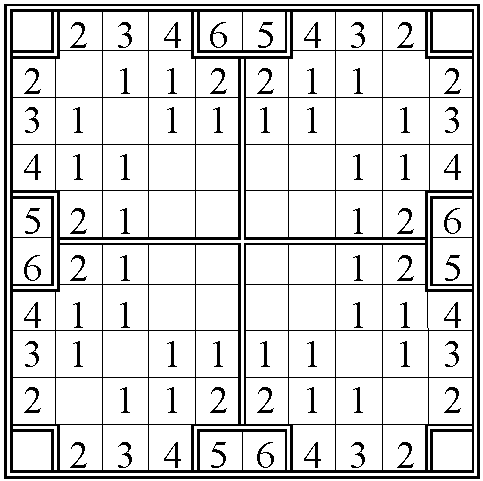Konfusion is an An Abstract Strategy Dice Chess Game I created some time ago which a number of you may enjoy.
This game is a simple chess variant which uses a 10X10 checkered board and dice instead of a standard chess board or pieces. The game can be played with two to four players.
The blank board has hemisphere divisions as well as certain boxes marked off in the corners and the middle back row of each player’s position:

Players sit across from one another. Each player begins play with 18 six-sided dice which are set up in front of them along their back three rows with the pips showing as follows:
1 1 2 2 1 1
2 3 4 5 6 4 3 2
The complete board set up for a four-player game would look as follows with the numbers representing the pips showing for each player’s dice and their positions on the board:

Each player should use a different color of dice (if you don’t have different colored dice, then try to use diffferent sizes or have some other way of differentiating which dice belong to each player).
The object of the game is either to remove all of an opponent’s pieces from the board or to capture the four key positions in the opposite row – the four boxed pieces in the corners and in the middle of the opposite row. You will note that in a three- or four-player game, some keyposts are shared by different players.
Play is very simple. Players decide who goes first (usually by a roll of the dice but other methods are fine if agreed upon by all players). In turn, players move one piece each turn (alternatively, players may roll a die to determine the number of pieces they may move on their turn). Each die of a certain value may move differently:
| May move one space forward, left, or right only. | |
| May move two spaces diagonally forward only. | |
| May move three spaces forward, backward, left, or right. | |
| May move four spaces in a diagonal direction forward or backward. | |
| May move five spaces continuously in any direction. | |
| May move six spaces in any direction, changing direction as desired. |
Pieces may capture only if they land on an opponent’s piece in the final space of their move. If another piece blocks a piece from continuing before it takes its final step in a normal move, then the piece may stop at that point or “jump” intervening pieces to capture a space. If there are no intervening pieces, then the piece must move it’s full allotment of spaces as determined by its pip value – except when landing on a keypost as described below. If a piece hits the wall during it’s move and it has more spaces in it’s move, it may continue on in the opposite direction – ricocheting onward.
If a piece enters a keypost space (it’s own or an opponent’s), it may discontinue further movement and immediately upgrade it’s pip value one spot (a “one” becomes a “two,” a “three” becomes a “four,” etc.). A “six” may not upgrade in this manner – however there may be several “sixes” in play at any time because of pip upgrading.
If a “one die” lands on any square on the far row, that die is immediately upgraded to a value of “six.”
Victory is declared as soon as one player has pieces occupying the four opposite keyposts or the moment all of one player’s pieces are removed from play.
In a three- or four-player game, if a victory is declared by removing all of one player’s pieces from the game then the player who has the most points still on the board is the winner – add the pip values of the remaining pieces to determine victory points. In case of a tie, add the total point values for all captured pieces in each player’s possession to determine a winner. If there is still a tie, then the game is a draw. In points tournament play, each tying player would score a win (championship matches would be replayed between the tying players).
Straightforward and simple . . . enjoy . . . or, not, as the case may be.
(Note: Slightly larger versions of the game board graphics can be found here.)






